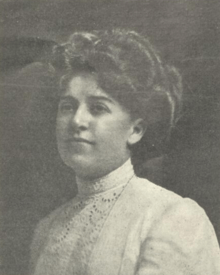Mildred Lovett
Mildred Esther Lovett (13 September 1880 – 23 March 1955) was a major figure in the early 20th century Tasmanian and Australian art scene, known as both an influential teacher and a versatile artist.[1]
Mildred Lovett | |
|---|---|
 Mildred Lovett in 1909 | |
| Born | Mildred Esther Lovett 13 September 1880 Hobart, Tasmania, Australia |
| Died | 23 March 1955 (aged 74) Sandy Bay, Hobart, Tasmania |
| Nationality | Australian |
| Known for | Portraiture, china painting, sculpture, art teaching |
| Spouse(s) | Stanley Livingstone Paterson |
Artistic career
Lovett studied at Mrs H. Barnard's Ladies School, Hobart, Tasmania from 1887–1893, where William Henry Charpentier taught her art.[1] At 13 she left school and found work as a photographic retoucher at McGuffie's 'Alba Studio' in Hobart (one of the few jobs available at the time for talented school leavers).[2] Following this she spent five years at Hobart Technical College, studying painting, modelling, life drawing and china painting under Ethel Nicholls and Benjamin Sheppard.
In 1901, she moved to Sydney to study under Julian Ashton at his Sydney Art School, eventually becoming his assistant teacher.[3] In 1904 she returned to Hobart and began a distinguished career teaching in the Art Department of the Technical College, where she obtained a full-time post with a salary of 50 pounds per annum,[1] working under the leadership of Lucien Dechaineux.[4] By 1925 she had been appointed art instructor at the College. Many of her students became prominent artists, including Edith Holmes and Dorothy Stoner.[3]
Lovett was a key figure in the Hobart art scene, acting as a council member of the Art Society of Tasmania. Highlights of her career included representing Tasmania in the British Empire Exhibition in London in 1924 and being part of the 1926–27 Group of Modern Painters' founded by George Lambert who exhibited in Sydney.
In 1929 she took leave from her role at the Technical College to complete a study tour of Europe, where she enrolled at the Westminster School of Art, London, and at the Academie Lhote in Paris.[1]
She was highly proficient in oil, water and pastel painting, sculpture and miniatures. Her china painting brought her most critical acclaim, described by The Lone Hand in 1913 as being "…amongst the three or four great Australian painters on china".[2] A vase painted by Lovett, which now resides in the Art Gallery of NSW, is regarded as one of the key works of decorative art in the art nouveau style in Australia.[5] Her work is also held in National Gallery of Australia[6] and the Tasmanian Museum and Art Gallery.[7]
Personal life
Born in Hobart, Tasmania on 13 September 1880,[8] Lovett lived primarily in Tasmania and Sydney.[8] She was the eldest of four children (two girls and two boys) of Edward Frederick Lovett, and Alice Edith, née Gibson. They were a middle class family, with her father working as a railway clerk.[1]
At the age of 33 (in 1913), Lovett married Stanley Livingstone Paterson and became the family's major breadwinner for the 40 years of their marriage, supplementing her teaching wage with the sale of her work. Lovett and Stanley had no children.[2] She retired from the Hobart Technical College in 1940 and returned to Sydney with Stanley, where they lived until his death in 1952.[2]
Lovett died in Hobart in 1955 at the age of 75.[8]
References
- Finucane, Paul,. Odd roads to be walking: 156 women who shaped Australian art. Stuart, Catherine,. Skeagh, Ireland. ISBN 978-1-9161877-0-2. OCLC 1128186402.CS1 maint: extra punctuation (link) CS1 maint: multiple names: authors list (link)
- "Department of Premier and Cabinet". www.dpac.tas.gov.au. Retrieved 8 March 2020.
- Turnbull, Paul. "Lovett, Mildred – Biographical entry – Companion to Tasmanian History". www.utas.edu.au. Retrieved 8 March 2020.
- Institute of Architects of New South Wales (1 November 1909), "Miss Mildred Lovett: Some Notes on her China Painting", Art and Architecture: The Journal of the Institute of Architects of New South Wales, W. Brooks, 6 (6), ISSN 1833-2722
- "Works by Mildred Lovett :: The Collection :: Art Gallery NSW". www.artgallery.nsw.gov.au. Retrieved 8 March 2020.
- Lovett, Mildred. "The nude. [(Reclining nude - Dorothy Stoner).]". Item held by National Gallery of Australia. Retrieved 17 June 2020.
- Holmes, Jonathan; Lada, Elizabeth (1989). Mildred Lovett, 1880–1955, A Survey (PDF). Hobart, Tasmania: University of Tasmania. ISBN 0 85901 426 6.
- Backhouse, Sue; Kolenberg, Hendrik, "Lovett, Mildred Esther (1880–1955)", Australian Dictionary of Biography, National Centre of Biography, Australian National University, retrieved 8 March 2020